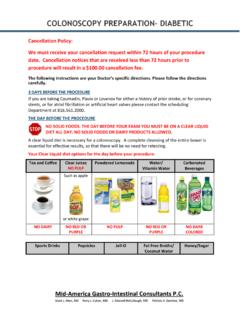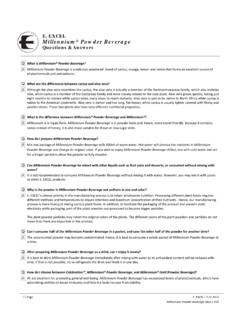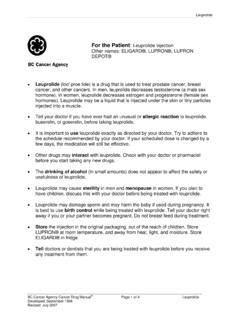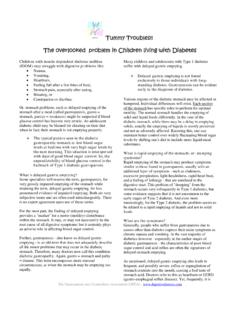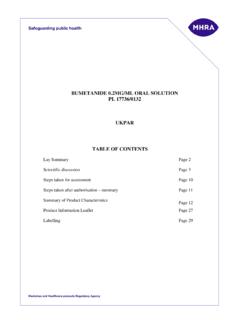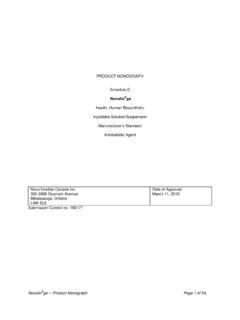Transcription of Periodontal osseous surgery post-operative instructions
1 Periodontal osseous surgery post - operative instructions Antibiotic If an antibiotic has been prescribed, start taking it the first day (unless directed otherwise). and use to completion. You can reduce stomach upset by taking it with food and/or plenty of liquid . Ibuprofen Unless you have a reason you can't take ibuprofen (such as an allergy to ibuprofen or aspirin, or a stomach ulcer), take 800mg of ibuprofen at a time, 3 times per day. Start the day of the surgery , and take for the next 2 days. After that you can still take it as needed for pain. Do not use ibuprofen for more than one week. Pain pills Take one pain pill as soon as you can after surgery .
2 It will usually work better if taken before the numbness wears off. After that, take only as needed. Take any narcotic pain pills with food and/or plenty of liquid . Do not drive after taking any narcotic pain pill and do not take them with sleeping pills or alcohol. Ice bag Use a cold pack (a plastic bag of frozen peas works well) to the face over the area where the procedure was done for 10 minutes at a time, twice an hour, for the first 6 hours. You can periodically use an ice bag the rest of the day of surgery and the next day. If you use the ice bag as directed, you should have less swelling than you would have otherwise.
3 Less swelling = less pain. Do not use hot packs or a hot water bottle. Sleep somewhat inclined For the first 2 nights after the procedure, sleep in a recliner chair or with your head propped up with some pillows. A recliner is a lot better. If you keep your head above your heart level for the first 2 days, it will significantly cut down on post -op swelling. Less swelling = less pain. Swelling Most people get some swelling and, if they do, it usually happens about 48-72 hours after surgery . Using the ice bag and sleeping inclined as directed above will help a great deal with keeping it to a minimum. liquid in the brown jar is chlorhexidine (Peridex ), a topical antiseptic.
4 Use a Q-tip to apply it. The ear cleaning Q-tips work best, as they are very absorbent and hold a good size drop of liquid . Apply about 3. times/day for 3 weeks to the surgical site by dabbing the soaked in chlorhexidine Q-tip to the surgical area. Do not scrub it in. During the 1st 3 weeks, whenever you do start any tooth brushing in the surgical site, dip the toothbrush in the chlorhexidine, as well. If you run out, call us to pick up more. Once this liquid is applied, do not eat, drink or rinse out for 30 minutes. Red handled toothbrush (if we gave you one) This is a Tepe Special Care toothbrush. It is soft as a mop, so is not a very good cleaning toothbrush, but helps without damaging the surgical site until it is healed better.
5 It is for use in the surgical area only. As noted above, dip it in the chlorhexidine. Use this toothbrush, as directed, for the first 2 weeks. If we placed a Periodontal dressing (pink cast) you can lightly clean the dressing with this toothbrush dipped in chlorhexidine. Use a regular toothbrush in the non-surgical areas. Oral hygiene Do not use a water-pik or an electric toothbrush around the surgical area for 4 weeks after the procedure. After that, it should be OK. Around the surgery area, for the first 2 weeks use the red handled toothbrush as noted above. You can brush the areas not worked on with your usual toothbrush.
6 Do not floss around the tooth/teeth worked on for 1 week, so you don't accidentally take out any of the stitches. After 2 weeks, there should be no oral hygiene restrictions, except for water-piks & electric toothbrushes as noted above. Salt-water rinses Rinse your mouth out (don't swish) with warm salt water (1/2-tsp. salt in 8-ounce glass of 120-degree water). Hold this in the mouth for 30 seconds and spit out. Repeat. Do this 4-5 times per day for 7 days. Start the day after oral surgery . Exercise Avoid strenuous exercise for the first 7 days. Strenuous physical activity may increase post - operative pain or cause post - operative bleeding and swelling.
7 Less activity equals less pain. Touching the surgical site It is important that the surgical site remains untouched during the initial stages of healing. We recommend that you avoid stretching your mouth to look at the site, use caution when washing your face, and avoid playing with your tongue on the surgical sites. Stitches If the stitches are dissolvable, they should fall out in 3 to 7 days. If they dangle and bother you, cut the dangling part with a small bathroom scissors. If the stitches are not dissolvable, they will need removed in about 7-10 days. Bleeding Pink saliva is normal for a few days. If you get any bleeding, you need to apply pressure.
8 Many patients will have some. Wipe it clean of any blood clots first. It has to be thoroughly cleaned first. Then apply gentle (it doesn't need to be real hard) pressure to the cheek and tongue side of the surgical area for 10 straight minutes with a soaking wet tea bag (black tea works best), or a soaking wet gauze pad, or a clean wash cloth, etc. Be sure it is soaking wet. If it is not, the clot will stick to it and start bleeding again when you pull it away. If it just won't stop, call. Food Stay on a soft diet, chew away from the surgery area and avoid any foods that would be more likely to get stuck in the surgery site, such as corn, popcorn, nuts, and seeds (fruits like strawberries have seeds).
9 Do this for up to 3 weeks. Citric juices, carbonated beverages or acidic foods, like tomatoes, may make it hurt, but won't damage the healing, though. For the first 7 days avoid really hot foods or drinks. Several glasses a day for the 1st week or 2 of a nutritional food supplement (Carnation Instant Breakfast drink, Ensure, Slim-Fast, etc.) is advisable as a food supplement. Ensure makes a product called Glucerna for diabetics. After 3 weeks, there should be no eating restrictions. Nothing but light sucking with a straw for the first 2 weeks. No milkshakes with a straw for 3 weeks. Nightguard If you have a nightguard, you should wear it during the healing time and thereafter (if it causes you discomfort you don't have to wear it until any discomfort goes away).
10 Smoking Pain rates are higher and healing slowed with smoking within the first 3 weeks. If you do smoke, keep it 5 cigarettes or less per day and only smoke half the cigarette. No cigars or pipes. Aspirin Unless you have a special medical reason for taking aspirin (tell us at least a week ahead of time if this is the case), do not take aspirin products for 7 days prior to thru 7 days after the surgery procedure. Aspirin can cause bleeding. osseous surgery po sheet

